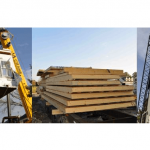What’s the Difference Between a Green Home and an Energy Efficient Home?


Many people use the terms “green” and “energy efficient” interchangeably. However, they aren’t necessarily the same. Even builders use them interchangeably which just adds to the confusion for home buyers researching building a new home. A green home is built from environmentally friendly materials. Being green doesn’t necessarily mean that a home is energy efficient. It can be, but this is where the confusion begins. Let’s examine what the two terms really mean and see how they can impact that home you think you are getting.
What is a Green Home?
No government standard defines what makes a green home green. There are many organizations that have created “green standards” and awards certification based on those standards. More on that later. A basic definition of green today is a home that is ecologically/environmentally friendly. The “greenness” of a home can include the type of materials that are used to build it, using renewable energy sources to power the home, the efficient use and reuse of water in the home, and to some degree the actual energy efficiency of the home.
There are two eco-friendly ways to source materials for a green home:
Recycled Materials – Reclaiming and reusing materials is one way to reduce the environmental impact of a new home. For example, acquiring timber from a building that has been salvaged and then reusing that lumber in the construction of a new home. The goal is to reduce the number of trees that have to be cut down to build new homes thereby reducing the home’s impact on the environment. Another example is recycled steel. It is estimated that reclaimed steel from six cars can provide the materials necessary for a 2,000 sq ft home. The recycled steel requires 25% less energy to make than new steel.
 Sustainable Materials – These are materials that typically natural but that can be replenished or grown quickly. Examples include bamboo and straw. Bamboo is typically used for flooring. It can be grown quickly and has a very high tensile strength and hardness. Straw can be used for insulation. Straw is a waste product from the growing of wheat.
Sustainable Materials – These are materials that typically natural but that can be replenished or grown quickly. Examples include bamboo and straw. Bamboo is typically used for flooring. It can be grown quickly and has a very high tensile strength and hardness. Straw can be used for insulation. Straw is a waste product from the growing of wheat.
What is an Energy Efficient or High Performance Home?
An energy efficient home has less to do with how the materials were obtained or created and more about how the building materials perform to improve a home’s energy efficiency. The building materials are combined into systems that work together to create a highly efficient home that is also known as a high performance home. There are several critical areas or systems that are focused on to promote energy efficiency:
Thermal Envelope – The thermal envelope of a home is what separate the conditioned space of a home from the unconditioned space of a home. This can include walls, roofs, floors, windows, and doors. The goal is to eliminate holes that can occur in the thermal envelope so the conditioned space doesn’t exchange air with the unconditioned space in an uncontrolled manner (see ventilation below).
Heating and Cooling – Reducing the energy required to heat and cool a home critical in achieving a high performance home. Heat pumps have proven to be one of the most efficient ways to heat and cool the average home. However, heat pumps suffer from leaky ducts. Another option is a ductless heat pump (or a mini-split). These systems don’t suffer from duct leakage and are highly efficient.
Ventilation – With a home’s thermal envelope being well sealed, the unwanted movement of air is virtually eliminated. But that can be a problem. A home that is well sealed but has moisture can become a breeding ground for mold and cause countless other issues for its occupants with a lack of ventilation. It is important to manage the indoor air quality mechanically so it remains a healthy living environment that promotes energy efficiency.
Windows and Doors – Windows and doors are necessary for every home. However, they reduce efficiency in a home’s thermal envelope. The industry has created a window with double and triple panes, gases that fill the void between, and films that apply to the window to reduce solar gain and heat loss. Windows play a critical role in the energy efficiency of a home.
Solar Gain – Some people think that reducing the number of windows and doors is a way to promote energy efficiency. That isn’t necessarily true. There is a concept know as Solar Tempering. With proper home positioning and window shading the sun can be used to promote the heating of the home in the winter but with reduced impacts in the hotter summer. Controlling and managing solar gain through the seasons can help reduce the cost of heating and cooling thereby increasing energy efficiency.
What Do All of the Certifications Really Mean?
Whether it is a certification for a green home or a certification for a high performance home, here are some organizations and certification to explore as you investigate how you want to construct and design your new home:
LEED (Leadership in Energy and Environmental Design) certification from the U.S. Green Building Council, now also being applied internationally.
RELATED: Why New Homes are More Energy Efficient
The National Green Building Standard™ certification goes well beyond saying a home is energy efficient; it provides independent, third-party verification that a home, apartment building, or land development is designed and built to achieve high performance in six key areas: Site Design, Resource Efficiency, Water Efficiency, Energy Efficiency, Indoor Environmental Quality, and Building Operation & Maintenance.
Energy Star ratings for appliances, but also for construction components such as windows. Originally American, the Energy Star system has also been adopted now also adopted by Europe as well as Australia, Canada, Japan, New Zealand, and Taiwan.
The DOE Zero Energy Ready Home, represents a whole new level of home performance, with rigorous requirements that ensure outstanding levels of energy savings, comfort, health, and durability. This program typically exceeds the requirements of the Energy Star Program.
MODULAR HOMES: ENERGY EFFICIENCY IS DESIGNED IN
When it comes to building a home with modular construction, energy efficiency is a natural part of the construction process. When a home is built indoors, it isn’t subject to the elements. Lumber isn’t getting wet or drying in the sun. It isn’t going to shrink or swell later creating gaps and air leaks. It is easier to build to tighter tolerances and then to inspect to ensure those tolerances are maintained when building indoors in a factory.
Modular construction means that a home is built in a manufacturing environment just like every other product or item you use every day. Modular construction means your home is built to last and built to perform at a higher level for years to come. It is quality and efficiency you can count on. Impresa Modular delivers the most Advanced Modular Off-Site Solution (AMOSS).
The post What’s the Difference Between a Green Home and an Energy Efficient Home? appeared first on Impresa Modular.




